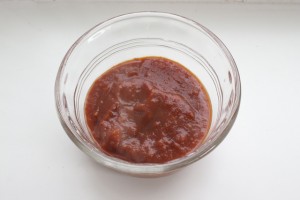Sometimes I spend an absurd amount of time at the grocery store. I read label after label after label searching for ingredients that I’ll feel “okay” about feeding to my family.
I’ve been on the lookout for info on high-fructose corn syrup (HFCS) ever since my husband read The Omnivore’s Dilemma: A Natural History of Four Meals about the craziness of the corn industry and how much corn we Americans truly consume through packaged goods, fast food, condiments and even our corn-fed meat.
Honestly, it’s a little freaky.
I now agree completely with food industry analysts like Mark Bittman who recently wrote about food subsidy reforms being needed to encourage real farming of healthy fruits and vegetables instead of corn, corn and more corn.
This quote from Bittman stuck in my brain as a big reason to basically boycott HFCS…
The subsidy-suckers don’t grow the fresh fruits and vegetables that should be dominating our diet. Indeed, if all Americans decided to actually eat the five servings a day of fruits and vegetables that are recommended, they would discover that American agriculture isn’t set up to meet that need. They grow what they’re paid to grow: corn, soy, wheat, cotton and rice.
Dumping the high-fructose corn syrup from our food is not so easy to do. While some food companies are touting their elimination of corn syrup due to consumer demand, many haven’t budged. It’s in everything from Frosted Mini Wheats, to Heinz Ketchup, to pancake syrup, to jams, to bread, to hamburger buns, and on, and on, and on. I even found it in some deli-mustard. Who needs corn sugar in mustard?
Now, you may ask, “I still don’t get it. Is there a health issue with high-fructose corn syrup?”
Well, in my research, I found some studies that link HFCS to our country’s obesity epidemic, claiming that our bodies react differently to HFCS than sugar. We gain more weight, boost our triglicerides and build fat around our bellies. It’s also “sweeter” than sugar which effects our palates so we crave sweeter and sweeter foods.
Yet, there are credible sources that claim that what’s true about HFCS health effects is also true about sugar. It’s the amount of intake not the type of sugar, and we all just need to back off the sweets (Mayo Clinic and WebMD).
Either way, you need to know that when you see HFCS in the ingredients, you are getting something your body does not need. Be especially aware of products that list both high-fructose corn syrup and corn syrup in the ingredients. That’s basically a sneaky way for corn sugar not to be labeled as the first ingredient.
Okay, so enough with the rant and onto a recipe. After cringing at the sight of my kids dipping chicken nuggets into high-fructose corn syrup, I decided to fix at least one of those pitfalls. This is an HFCS-free, slightly sweet, tomato-based BBQ sauce with just a tiny-kick. I tastes fantastic and is perfect for kids (and grown ups) who like to dip.
I’ve got big plans to use it as an ingredient in some upcoming meals as well.
Ingredients List
- 1 Tbsp extra virgin olive oil
- 4 garlic cloves, minced
- 1 small, yellow onion, minced
- 1 (15oz) can tomato sauce
- 1 (6oz) can tomato paste
- 1/2 cup dark beer (I used Black Butte Porter)
- 2 Tbsp rice vinegar
- 1 Tbsp soy sauce
- 2 Tbsp brown sugar
- 1/2 tsp dry mustard
- 1 Tbsp chili powder
- 1/2 tsp cayenne pepper
Method
Warm olive oil in a medium-sized sauce pan. Add garlic and onion and cook for 3 minutes.
Reduce heat to low. Add the remaining ingredients to the pan and simmer for 10 minutes. Stir frequently to prevent burning.
Allow sauce to cool to room temperature before serving or refrigerate and serve cold.
Note: the sauce tastes even better after a few days of mellowing in the refrigerator and should last for at least one week. And, if you like your BBQ sauce super smooth, use a food processor for mincing the garlic and onion or put the sauce in a blender after cooling.

Leave a Reply